
Eriogonum strictum is a species of wild buckwheat known by the common name Blue Mountain buckwheat. It is a common plant of western North America from northern California to British Columbia where it is found along rocky slopes and scrubland.

Horkelia marinensis is a rare species of flowering plant in the rose family known by the common name Point Reyes horkelia. It is endemic to the California coastline, where it is known from about Fort Bragg to near Santa Cruz. It grows on beaches and in other sandy coastal areas. This is a perennial herb growing in low, dense patches. The leaves are up to 10 centimeters long and are made up of toothed, hairy, gray-green leaflets each around a centimeter long. The foliage is glandular and strongly scented. The plant produces green to reddish-green stems up to 30 centimeters long which bear inflorescences of dense clustered flowers. Each flower has minute bractlets under reddish-green, fuzzy sepals. The petals are generally white and narrow with rounded ends. The center of the flower contains a ring of stamens around a patch of 20 to 30 pistils.

Allium tuolumnense is a rare species of wild onion, known by the common name Rawhide Hill onion.
Allium parryi is a North American species of wild onion known by the common names Parry's onion and Parry's fringed onion. It is common in the Coast Ranges of southern California and northern Baja California. It is also known from the southernmost reaches of the Sierra Nevada.
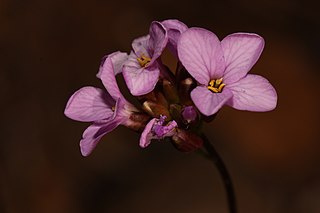
Arabis aculeolata is a species of flowering plant in the mustard family known by the common name Waldo rockcress. It is native to a small range in the mountains of southern Oregon, where it is an uncommon member of the serpentine soils flora. Reports of its occurrence in Del Norte County, California are unconfirmed.
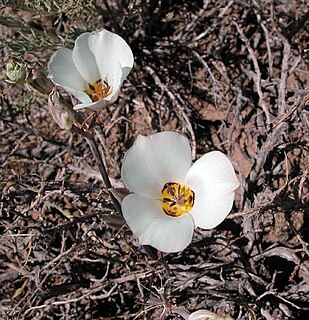
Calochortus bruneaunis is a species of flowering plant in the lily family, and is known by the common name Bruneau mariposa lily.

Calyptridium roseum, synonym Cistanthe rosea, is a species of flowering plant in the family Montiaceae commonly known as rosy pussypaws. It is native to the western United States from California to Wyoming, where it grows in forest and scrub. It is an annual herb, often reddish or pink in color, producing stems just a few centimeters long. The leaves are located in a rosette at the base and along the stems, and are up to 4 or 5 centimeters long. The inflorescence is a tiny cluster of white-edged thin sepals and two white petals, each no more than a millimeter long.
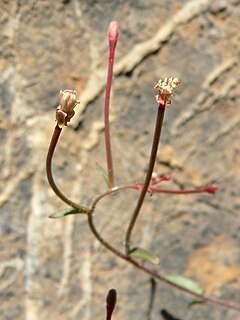
Eremothera chamaenerioides is a species of evening primrose known by the common name long-capsule suncup. It is native to the southwestern United States and northern Mexico, where it grows especially in desert regions. It is an annual herb producing an erect, hairy, glandular stem which is reddish in color and up to half a meter tall. The leaves are lance-shaped or oval and up to 7 or 8 centimeters long. The nodding inflorescence produces several flowers, each with white petals a few millimeters long and drying to dull red. The fruit is a capsule 3 to 5 centimeters long.
Carex amplifolia is a species of sedge known by the common name bigleaf sedge. It is native to western North America from British Columbia to Montana to California, where it grows in wet and seasonally wet areas in coniferous forests.
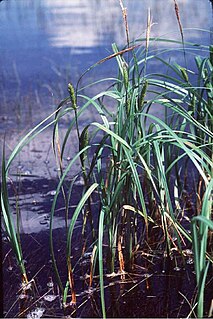
Carex atherodes is a species of sedge known by the common name wheat sedge. It is native to Eurasia and much of North America including most of Canada and the United States. It is a very common wetland plant across the American Midwest and areas west. It grows in moist and wet habitat, such as marshes and moist prairie land, and it may grow in shallow water. This sedge produces triangular, hollow stems 30 to 120 centimeters tall. The leaves are hairy, especially on the lower parts, and the leaf sheath is tinted with reddish purple. The inflorescence is up to 60 centimeters long and made up of several spikes; those spikes near the tip are usually staminate, and those lower in the inflorescence are usually pistillate. The tip of each fruit has two or more long, thin teeth.
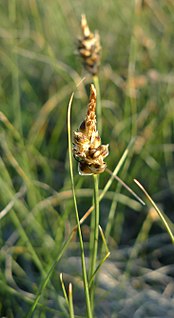
Carex filifolia is a species of sedge known by the common name threadleaf sedge.

Clarkia arcuata is a species of flowering plant in the evening primrose family known by the common name glandular clarkia. It is endemic to California, where it grows in the chaparral and woodlands of the foothills of the Sierra Nevada and southern Cascade Range. It is an annual herb producing a slender, erect stem often exceeding half a meter in height. The leaves are narrow, usually linear or lance-shaped, and up to 6 centimeters long. The inflorescence bears a few flowers, which dangle when they are buds and grow erect as they open. The sepals stay fused as the petals open and emerge from one side. They are coated in glandular hairs. The petals are up to 3 centimeters long, pink-lavender in color, sometimes with a reddish blotch at the base. They form a bowl-shaped corolla. There are 8 stamens and a protruding, four-chambered ovary. The fruit is an elongated capsule which may reach 3.5 centimeters long.
Collinsia corymbosa is a species of flowering plant in the plantain family known by the common name round-headed Chinese houses. It is endemic to the coastline of California north of the San Francisco Bay Area, where it is uncommon and scattered. Its habitat is the sand dunes of the immediate coastline. This is an annual herb producing a scaly, hairy, red to reddish green stem which grows upright or decumbent to a maximum length of about 25 centimeters. The thick, sparsely hairy leaves are rippled and lobed along the edges, which may be somewhat turned under. The inflorescence is a dense whorl of several distinctive flowers. Each has a hairy calyx of lobed reddish sepals and a corolla up to about 2 centimeters long. The flower has two small upper lobes and three longer lower lobes which come together in a nearly tubular shape. It is generally white with a light purple tint. The smaller upper lobes curl back and dry to brown at their lips.

Eriogonum eremicola is a rare species of wild buckwheat known by the common names Telescope Peak buckwheat and Wild Rose Canyon buckwheat. It is endemic to Inyo County, California, where it is known from only a few occurrences in the Inyo Mountains and Telescope Peak in Death Valley. It grows in sandy to rocky habitat in the forests and woodlands of these desert mountains. It is an annual herb producing a spreading, glandular, reddish green stem up to about 25 centimeters tall. The rounded, woolly leaves are up to about 2.5 centimeters long and are located at the base of the stem. The scattered inflorescences are small clusters of tiny flowers which are white with reddish stripes, aging to solid red, or sometimes yellow. The plant is under protection in Death Valley National Park.
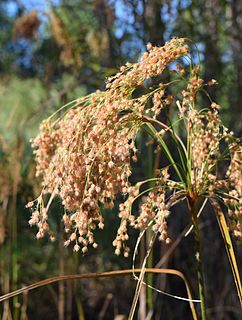
Scirpus cyperinus, commonly known as woolgrass, is a herbaceous emergent that is native to the eastern United States and eastern Canada. Other common names include cottongrass bulrush and brown woolly sedge.

Lythrum portula is a species of flowering plant in the loosestrife family known by the common names water-purslane and spatulaleaf loosestrife. It is native to Europe, and it is found in parts of western North America as an introduced species. It often grows in moist habitat, such as marshes. This is a prostrate annual herb producing a hairless, reddish stem up to 25 centimeters long which lies along the ground and roots where its nodes come in contact with wet earth. The slightly fleshy, spoon-shaped leaves are about a centimeter long and greenish to reddish in color. Solitary flowers occur in leaf axils. Flowers often have white or pink petals about a millimeter long, but some lack petals. The fruit is a spherical capsule containing minute seeds.

Pyrrocoma apargioides is a species of flowering plant in the aster family known by the common name alpineflames. It is native to the western United States from the Sierra Nevada of California east to Utah, where it grows in the forests and meadows of high mountains. It is a perennial herb growing from a taproot and producing one or more stems to 30 centimeters in length. The stems are decumbent or upright, reddish, and hairless to slightly woolly. Most of the leaves are located around the base. They are thick and leathery, lance-shaped with large sawteeth along the edges, often center-striped in white, and measure up to 10 centimeters long. The inflorescence is usually a single flower head lined with centimeter-long phyllaries which are reddish to green with red edges. The head has a center of yellow disc florets and a fringe of ray florets which are yellow, often splashed with red along the undersides, measuring up to 1.6 centimeters in length. The fruit is an achene which may be well over a centimeter in length including its pappus.

Raillardella pringlei is an uncommon species of flowering plant in the aster family known by the common name showy raillardella. It is endemic to the southern Klamath Ranges of northern California, where it grows in moist forest habitat on serpentine soils. It is a rhizomatous perennial herb growing in a clump of rosetted basal leaves. The leaves are linear to lance-shaped with smooth or faintly toothed edges, up to 15 centimeters long, and mostly hairless. The plant produces an inflorescence generally 25 centimeters to half a meter tall consisting of a solitary flower head or an array of up to three heads. The head is bell-shaped, sometimes widely so. It contains many orange to red-orange disc florets each about a centimeter long, and a fringe of several orange or reddish ray florets each up to 2 centimeters in length. The fruit is a long, narrow achene which may be 2 centimeters in length including its pappus of plumelike bristles.
Streptanthus oliganthus is an uncommon species of flowering plant in the mustard family known by the common name Masonic Mountain jewelflower. It is native to western Nevada and eastern California, where it grows in the rocky hills east of the central Sierra Nevada. Its habitat includes forest, woodland, sagebrush, and mountain talus. It is a rhizomatous perennial herb producing a hairless, waxy, usually unbranched stem up to about 40 or 50 centimeters in maximum height. The basal leaves have lance-shaped, smooth-edged blades up to 10 centimeters long borne on fuzzy to rough-haired petioles. Leaves higher on the stem have shorter blades which may clasp the stem at their bases. Flowers occur at intervals along the upper stem. Each has a bell-shaped calyx of purple sepals no more than a centimeter long. The petals emerging from the tip are reddish purple or purple-tipped. The fruit is a smooth, flat, straight or slightly curved silique up to 8 to 10 centimeters long.
Minuartia cismontana is a species of flowering plant in the family Caryophyllaceae known by the common name cismontane minuartia.















